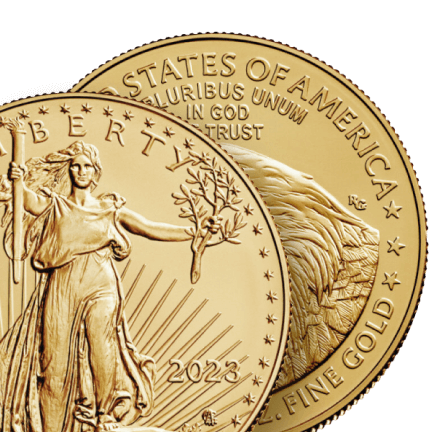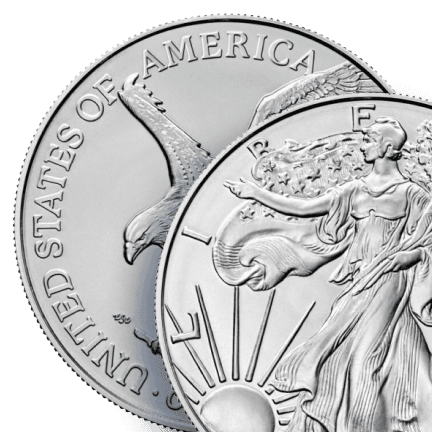Precious Metal Live Price Charts
Stay informed with real-time gold spot prices, in troy ounces (oz), kilos, and grams – in multiple currencies and comparison tools.
View Live Price Charts
Explore gold’s price history with these interactive charts including the gold/silver ratio (GSR), a globally-used indicator that reflects the multiple at which gold is trading compared to silver.
View Price Charts
Historical Prices of Gold and Silver
The price of gold today is determined by supply and demand as it is traded through large global markets of physical metals (from raw ore to refined bars and coins), and even contracts for future delivery at a specific price.
In the US, a market-determined gold price is a relatively recent development.
- For most of US history, the government set the gold-to-paper currency exchange rate:
- Early republic: $19.39/ounce.
- 1834: Increased to $20.67/ounce, remaining stable until 1933.
- In 1933, President Franklin Roosevelt:
- Increased the exchange rate to $35/ounce.
- Banned private ownership of gold bullion by US citizens.
- Canceled the convertibility of paper dollars to gold, making the price reflect only foreign demand.
- In 1972, President Nixon:
- Closed the “gold window,” ending foreign redemption of dollars for gold.
- Allowed citizens to own gold again.
- Permitted the gold price to float freely in the market.
Silver, by contrast, has always had a market-determined price, and its price history is marked by the sharp fluctuations you’d expect absent any constant-price peg determined by the federal government.
What Are the Historical Highs and Lows of Gold and Silver Prices?
All-Time Highs and Lows for Gold & Silver
(Based on London PM Fix Prices)
| Gold | Date | Silver | Date | |
|---|---|---|---|---|
| Historical High | $3,500.05 | April 22, 2025 | $50.00 | January 21, 1980 |
| Historical Low | $34.75* | January 16, 1970 | $1.27 | November 2, 1971 |
Note: Lows are for the modern era, since 1970.
*PM fix price, more commonly used in the US than AM price fix. Silver only has one daily fix price.
Price Predictions for Gold and Silver
Gold and silver are timeless safe havens, valued for their stability during economic, monetary, or geopolitical crises. Their prices often rise when inflation climbs or during financial uncertainty.
- Gold prices can soar during crises. For example, in the 1970s, gold rose over 2,300% due to economic turmoil. Today, with high financial risks, gold may reach new all-time highs, even five figures.
- Silver, a historical currency and industrial metal, often mirrors gold's trajectory. Experts suggest it could achieve high three-figure prices during severe crises.
Both metals serve as a hedge against financial catastrophe and remain valuable during hyperinflation or currency instability.
Frequently Asked Questions
What Is the Spot Price?
The spot price is the current market price for one troy ounce of a precious metal, such as gold or silver, in its pure form. It serves as the foundation for all transactions in the metals market.
Key Points About the Spot Price:
Universal Base Price:
Spot price is the baseline for pricing metals, regardless of whether they are quoted in grams, kilos, or ounces. These are simply conversions from the ounce-based price.
Currency Conversions:
Spot prices in other currencies, such as euros or yuan, are typically calculated using real-time foreign exchange rates.
Buy and Sell Dynamics:
- When buying, the price you pay is based on the ask price, which is slightly higher than the spot price.
- When selling, the price you receive is based on the bid price, which is slightly lower than the spot price.
The spot price fluctuates constantly based on global supply and demand, making it a crucial reference for traders and investors.
How Is the Spot Price of Precious Metals Determined?
The spot price reflects the current market price of precious metals and is primarily based on trading activity in futures markets. Here’s how it works:
Key Factors Influencing the Spot Price
Trading on Futures Markets:
Precious metals, like gold and silver, trade on futures exchanges much like stocks or other securities. COMEX, part of the CME Group, is the main exchange in the US that determines spot prices. These prices fluctuate throughout the trading day based on market activity.
Futures Contracts:
Gold futures contracts typically represent 100 ounces.
Silver futures contracts represent 5,000 ounces, though they can be split into smaller segments of 1,000 ounces.
Futures contracts are primarily traded by large financial institutions for speculative or hedging purposes, not by buyers intending to take delivery of the metal.
Retail Price Translation:
The spot price set on exchanges like COMEX filters down to the retail level. Dealers use it as a base to quote prices for physical precious metals, adjusting for premiums or discounts depending on market demand and supply.
Why the Spot Price Differs from Physical Prices
The spot price is driven almost entirely by “paper trades” — transactions involving futures contracts rather than physical metals. Since most participants in the futures market are not interested in owning physical gold or silver, the spot price reflects financial market activity rather than the actual cost of acquiring physical metals.
Spot Price Quotation
The spot price is quoted in US dollars but can be converted into other currencies based on real-time exchange rates.
For individual buyers, premiums above the spot price are added by dealers to cover manufacturing, transportation, and other costs associated with physical metals.
What Is the London Fix Price?
The London Fix Price is a globally recognized benchmark used to determine the price of gold and silver. It is distinct from the constantly fluctuating spot price and is primarily used for settling contracts in the London bullion market.
The London Fix Price plays a crucial role in global precious metals markets, providing stability and a standardized reference for pricing despite being inaccessible to individual retail investors.
Key Features of the London Fix Price
- Trading Hours and Global Markets:
Gold trades globally, with major exchanges in New York, London, and Shanghai.
Trading occurs from 6:00 a.m. to 5:15 p.m. Eastern Time, Sunday through Friday, with a brief daily closure.
During trading hours, the spot price fluctuates continuously based on market activity.
- London Fixing Process:
The London gold price fix is set twice daily at 10:30 a.m. and 3:00 p.m. (London GMT).
For silver, the fixed price is established once daily during business days.
The fix is determined through a conference call involving 12 of the world’s largest private banks.
- Purpose and Use:
The London Fix Price is primarily used to settle contracts between institutional participants in the London Bullion Market.
It serves as a reference rate for pricing gold and silver products and derivatives worldwide.
- Retail Limitations:
Retail investors cannot trade directly based on the fixed price. Instead, purchases are made using the spot price, often with an added premium.
Can You Buy Gold at the Spot Price?
The short answer is no, it’s highly unlikely. Here’s why:
What the Spot Price Represents
The spot price is the market price for “unfabricated” gold, typically in the form of 400-ounce Good Delivery Bars traded on futures markets. This price does not include the costs associated with transforming raw gold into retail-ready forms like coins, small bars, or jewelry.
Why You Pay a Premium
When buying gold, additional costs are added at various stages, including:
- Refining: Transforming raw gold into pure, market-grade metal.
- Fabrication: Manufacturing gold into coins, bars, or other retail forms.
- Dealership: Covering procurement, storage, and distribution costs.
These premiums ensure the supply chain remains profitable and are passed on to the buyer.
Cost Depends on Form
Your purchase price will vary depending on the form of gold you choose. For example:
- Coins often carry higher premiums due to minting and collectible value.
- Small bars generally have lower premiums than coins but higher than bulk gold.
- Jewelry includes additional costs for craftsmanship and design.
While the spot price serves as the baseline, the final price you pay will always include these additional costs.
What Is a "Premium"?
A premium is the amount you pay above the spot price for a precious metal product. It covers the additional costs involved in refining, molding, fabricating, and handling the metal.
Types of Products and Premiums
Bars (Lowest Premiums):
- Bars typically have the lowest premiums because they are simpler to produce.
- They can be poured or stamped with basic designs.
Coins and Rounds:
- Coins and rounds have slightly higher premiums due to intricate designs and stamping processes.
- Coins may also carry collectible or numismatic value.
Gold Jewelry (Highest Premiums):
- Jewelry often has the highest premiums, reflecting craftsmanship and design.
- Bullion jewelry, which is purely gold without heavy markups for artistry, offers a cost-effective option.
Why Premiums Matter
Every dealer adds a premium to the spot price. To get the best value:
- Look for reputable dealers with competitive premiums.
- Understand how premiums vary by product type to align with your investment goals.
Knowing how premiums work helps you make informed decisions when buying precious metals.
What Is the Gold/Silver Ratio and Why Is It Important?
The gold/silver ratio measures the relative value of gold to silver and is a key indicator for understanding price dynamics between these two precious metals.
How to Calculate the Gold/Silver Ratio
To find the ratio, divide the current price of gold by the current price of silver:
G/S Ratio = ( Spot price of Gold ) / ( Spot price of Silver )
What the Ratio Indicates
Historical Trends:
- Gold has consistently been more valuable than silver, but the ratio fluctuates as prices change.
Signals of Divergence:
- A high ratio (e.g., 80 or more) historically suggests that silver prices may rise, or gold prices may decline.
- A low ratio may signal the opposite, with gold poised to outperform silver.
Modern Range:
- In recent decades, the ratio has generally stayed between 50 and 80, with deviations often leading to a correction back toward the mean.
Why Is the Gold/Silver Ratio Important?
Market Analysis:
- The ratio helps investors identify potential undervaluation or overvaluation in one metal relative to the other.
Historical Context:
- Analysts like Mike Maloney study the ratio’s historical patterns to predict future movements and refine investment strategies.
By tracking the gold/silver ratio, investors can make informed decisions about adjusting their portfolios based on market conditions.






